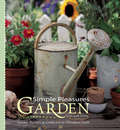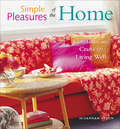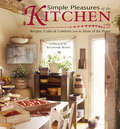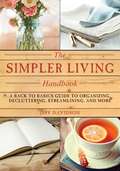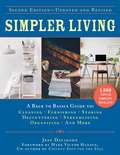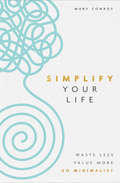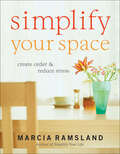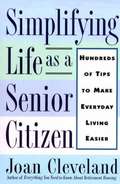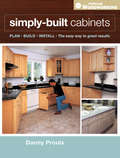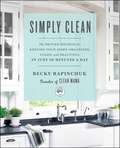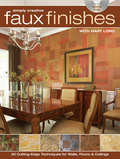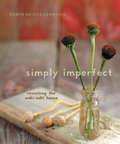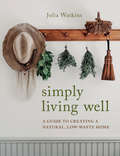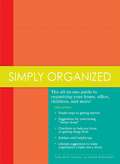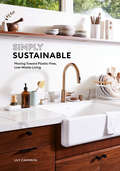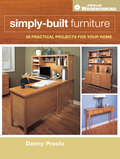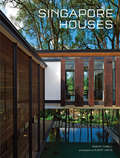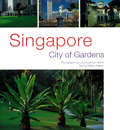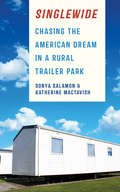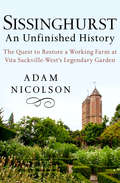- Table View
- List View
Simple Pleasures of the Garden: Stories, Recipes & Crafts from the Abundant Earth (Simple Pleasures Series)
by Susannah SetonA collection of gardening tips, recipes, crafts, gift ideas, tales, and more from the author of Every Garden Is a Story.Simple Pleasures of the Garden is a treasure chest of tips, how-to&’s, stories, and trade secrets gathered together in one beautiful book. Organized by season, the hundreds of suggestions and recipes present a profusion of ways to celebrate the bounty of the Earth all year round. Projects include handcrafted lotions and oils, baskets and wreaths, potpourris and floral waters, along with dozens of simple, inexpensive home decorations and easy-to-prepare recipes that utilize all of your garden&’s harvest. From compost tea to confetti corn chowder, Simple Pleasures of the Garden will inspire you to bestow the comforts and charms of your garden on family and friends.
Simple Pleasures of the Home: Comforts and Crafts for Living Well (Simple Pleasures Series)
by Susannah SetonA room-by-room guide to creating domestic bliss.Home—it’s the place where we can let down our hair, loosen our clothes, put our feet up. It’s where those we love most share in the ordinariness and extraordinariness of our days. It’s where many of us spend lifetimes trying to get back to. As the proverb goes, it’s where our hearts are.Simple Pleasures of the Home is for everyone who has the nesting impulse—from passionate and accomplished home decorators to anyone who simply enjoys domestic downtime. Organized room by room, the book includes dozens of:Simple activities for bringing the family togetherCreative ideas for pampering yourself and loved onesEasy-to-follow instructions for making aromatherapy productsTips for candlemakingComfort-food recipes, and more
Simple Pleasures of the Kitchen: Recipes, Crafts & Comforts from the Heart of the Home
by Susannah SetonA collection of recipes, crafts, and activities to bring your family together in the kitchen, from the author of Simple Pleasures of the Garden. The kitchen really is the heart of the home. It&’s the first place family and friends gather, not only to prepare and eat food, but to chat, sip tea, snack on home-baked cookies, unwind after a tough day, and reconnect with loved ones. The latest in the Simple Pleasures series of books, Simple Pleasures of the Kitchen captures the essence of the kitchen. It offers a cornucopia of recipes, food-based crafts, food facts and tips, and family activities, as well as stories from kitchens around the world sure to warm anyone&’s heart, no matter what the weather. Organized by season, the book offers: Spring Flings, The Savor of Summer, Autumn&’s Abundance, and Cozying Up in Winter. Recipes include comforting mashed potatoes, fresh summer risotto, delicious meatloaf, and heart-warming brownies and popovers. The super-simple jam recipe will go great with popovers, or as a gift in jars you&’ve decorated yourself. You can satisfy your sweet tooth and your soul at the same time! Susannah Seton&’s Simple Pleasures books continually delight readers with their down-home recipes, crafts, and activities that bring the whole family together. Don&’t miss this one.&“This enchanting and entertaining book reminds us of the importance of these times, how the simplest of events and day-to-day activities all blend to create cherished memories.&”—Jonathon King, cofounder of Stonewall Kitchen, from the Introduction
Simpler Living Handbook: A Back to Basics Guide to Organizing, Decluttering, Streamlining, and More
by Jeff DavidsonThe ultimate guide to streamlining your life.Life moves too quickly these days, as technology, work, and personal commitments make it almost impossible to relax and enjoy life. Finding yourself stressed over the clutter in your kitchen or the mass of paper in front of your computer? Relax. This book will help. Filled with tips on how to uncomplicate your daily routine, eliminate stress at home and work, and more, this book will help you free up your time so you can once again enjoy doing the things you love. Author Jeff Davidson has compiled more than 1,500 ways to simplify your life.Divided into sections for easy reference, this book will show you ways you can eliminate stress in your home, your personal life, and your professional life. You will learn the six questions you should ask yourself before buying something new, the most efficient way to clean your pots and pans, the pay-ahead technique to get yourself out of debt, ways to make your commute more comfortable, and advice on hassle-free vacation planning for you and your family. Simpler Living Handbook is the guide you've been looking for to lead the peaceful, productive life you've always wanted.
Simpler Living, Second Edition—Revised and Updated: A Back to Basics Guide to Cleaning, Furnishing, Storing, Decluttering, Streamlining, Organizing, and More (Back to Basics Guides)
by Jeff Davidson1,500 Ways to Declutter, Organize, Streamline, and Reclaim Your Space and Your Time! Life moves too quickly these days, as technology, work, and personal commitments make it almost impossible to relax and enjoy life. Finding yourself stressed over the clutter in your kitchen or the mass of paper in front of your computer? Relax. This book will help. Filled with tips on how to uncomplicate your daily routine, eliminate stress at home and work, and more, this book will help you free up your time and your space so you can once again enjoy doing the things you love. Author Jeff Davidson has compiled more than 1,500 ways that you can simplify your life. Divided into sections for easy reference, this book will show you ways you can eliminate stress in your home, your personal life, and in your professional life. You will learn the six questions you should ask yourself before buying something new, the most efficient way to clean your pots and pans, the pay-ahead technique to get yourself out of debt, ways to make your commute more comfortable, and advice on hassle-free vacation planning for you and your family. This book is the guide you&’ve been looking for to lead the peaceful, productive life you&’ve always wanted.
Simpler Living: A Back to Basics Guide to Cleaning, Furnishing, Storing, Decluttering, Streamlining, Organizing, and More
by Mark Victor Hansen Jeff DavidsonLife moves too quickly these days, as technology, work, and personal commitments make it almost impossible to relax and enjoy life. Finding yourself stressed over the clutter in your kitchen or the mass of paper in front of your computer? Relax. This book will help. Filled with tips on how to uncomplicate your daily routine, eliminate stress at home and work, and more, this book will help you free up your time so you can once again enjoy doing the things you love. Author Jeff Davidson has compiled more than 1,500 ways that you can simplify your life. Divided into sections for easy reference, this book will show you ways you can eliminate stress in your home, your personal life, and in your professional life. You will learn the six questions you should ask yourself before buying something new, the most efficient way to clean your pots and pans, the pay-ahead technique to get yourself out of debt, ways to make your commute more comfortable, and advice on hassle-free vacation planning for you and your family. This book is the guide you've been looking for to lead the peaceful, productive life you've always wanted.
Simplicity at Home: Japanese Rituals, Recipes, and Arrangements for Thoughtful Living
by Yumiko SekineA gorgeous guide to creating a beautiful, comfortable home based on Japanese traditions from the founder of the beloved lifestyle brand Fog Linen Work.For anyone who dreams of a home filled with well-organized closets, eye-catching flower arrangements, perfectly draped blankets, and thoughtfully curated shelves, here is a guide to cultivating an elegant home.Yumiko Sekine, founder of the internationally celebrated lifestyle brand Fog Linen Work, shares lovely rituals and simple techniques based on Japanese traditions, including practices for decorating, organizing, preparing food, and more. From the kitchen to the bedroom and every space in between, here are tips for refreshing a home each season—arranging and displaying fresh flowers in spring, choosing the right sheets and linens for summer, taking warm herbal baths in autumn, and draping blankets and layering rugs to cozy up a space for winter. Brimming with easy-to-follow tips for elevating any space and packed with hundreds of photographs showcasing gorgeous interiors, this book is an invitation to create a home that nourishes, rejuvenates, and inspires—all year long.• CELEBRATED AUTHOR: Yumiko Sekine is the founder of Fog Linen Work, a Japanese home goods brand sold throughout the world and beloved by home cooks, interior decorators, and design enthusiasts. Her products are known for their simplicity, beauty, and ability to elevate any space. In this book, Sekine distills all her secrets to creating a home that exudes simple elegance.• ORGANIZATION MADE EASY: This book gives readers easy, elegant ways to declutter their homes and organize their belongings, whether they live in an apartment or house, and includes simple tips for tidying and curating objects to bring order and simplicity to every room.• JAPANESE TRADITIONS: Yumiko presents Japanese traditions for preparing food, arranging flowers, entertaining, organizing, and more. The combination of ancient practices and modern techniques makes this the perfect companion for anyone curious about Japanese culture and aesthetics.• GIFT WORTHY: Presented in a linen-wrapped case and brimming with hundreds of gorgeous photographs and inspired advice for every home, this book is a perfect addition to any bookshelf and a lovely gift for new homeowners, newlyweds, and fans of organization and interior design.Perfect for:• Interior designers, minimalists, and fans of sustainability• People who are into organizing their space• Fans of Fog Linen Work
Simplify Your Life: Waste Less, Value More, Go Minimalist
by Mary ConroyMinimalism is for rich people who live in big, empty, white homes, right? Wrong. Minimalism can be a beautiful, enriching and life-transforming practice that, at its core, is all about re-establishing what holds value in your life and letting go of what does not. It's not about having your groceries displayed in glass jars or having chic, Scandinavian furniture - it's a way of life that allows us to strip away the clutter that stands in the way of us achieving our goals. Simplify Your Life is about exactly that: bringing simplicity back into your life, and with it, joy in the everyday. Dispelling the myths that minimalism is for either hardcore environmentalists or the privileged few, this book shows how minimalism is more relevant and necessary than ever, not least because it's the most accessible way to achieve a state of contentment in all aspects of life. Minimalism is for you if you want to: • stop mindlessly scrolling and start living with intention and purpose • spend more time on the things and people you love and less on what you "have to be/do" • take control of your finances and stop mindless spending • learn more about conscious consumption and reducing your waste • experience freedom and pride in your home instead of feeling trapped by your stuffAlthough minimalism is ostensibly about taking things away from our cluttered lives, it is really about adding richness, color, and meaning to our lives. It's about identifying the aspects of our life that we truly love and that nourish us. It's about trusting ourselves and leading the life we always wanted.
Simplify Your Space: Create Order & Reduce Stress
by Marcia RamslandPractical tips for organizing the spaces in your home help meet the needs for order in life.Would you like to clear out some of the clutter in your home? Do you ever wonder where all this stuff has come from feeling like things have maybe gotten a bit out of control? Join Marcia Ramsland, the organizing pro, as she leads you in a room-by-room approach to simplifying your home and office. Simplifying your space is the process of organizing your belongings and letting go of the excess until your surroundings are peaceful and in order. Using the CALM approach; C=Create a Plan, A=Approach it by Sections, L=Lighten up and Let Go, and M=Manage it Simply; Marcia guides readers in creating a more stress-free life. Includes 52 space saving tips, checklists, helpful diagrams, and even decorating ideas!
Simplifying Life as a Senior Citizen: Hundreds of Tips to Make Everyday Living Easier
by Joan ClevelandProviding solutions for common problems that afflict the daily lives of the elderly, this book presents information to help readers save time, money, frustration, and pain. Includes chapters of tips for managing vision loss, hearing loss and loss of mobility. The book provides chapters of easily read one-line tips that address a variety of broad as well as specific situations.
Simply Built Cabinets
by Danny ProulxYes, cabinets are those things that make up the storage in a kitchen. And they are the built-in storage spaces in your bathroom, den and other rooms. But cabinets are also free-standing storage units like bookcases. Building cabinets is really building boxes and there are simple techniques to create solid, quality cabinets that look great.Learn easy steps for making doors and drawers for your cabinets; how to make counter tops, install hardware and more.
Simply Clean: The Proven Method for Keeping Your Home Organized, Clean, and Beautiful in Just 10 Minutes a Day
by Becky RapinchukFrom the cleaning and homekeeping expert and creator of the wildly popular Clean Mama blog comes a simple and accessible cleaning guide with a proven step-by-step schedule for tidying a home in just ten minutes a day.Becky Rapinchuk, the “Clean Mama,” understands that many people don’t have the time, organizational skills, or homemaking habits to maintain a constantly clean and decluttered living space. In Simply Clean, Becky will help you effortlessly keep a tidy house and build habits to become a neat person—no matter how messy you may naturally be! Simply Clean features: -A 7-Day Simply Clean Kick Start and the 28-Day Simply Clean Challenge, to turn cleaning from a chore into an effortless habit -A designated catch-up day, so you’ll never have to worry or stress when life gets in the way of cleaning -Step-by-step tutorials for speed cleaning hard-to-clean spaces -Dozens of recipes for organic, environmentally conscious cleaning supplies -Many of Becky’s famous checklists, schedules, and habit trackers No matter how big your home or busy your schedule, the Simply Clean method can be customized to fit your life. It really is possible—in just ten minutes a day, you can create a cleaner, happier home.
Simply Creative Faux Finishes with Gary Lord: 30 Cutting Edge Techniques for Walls, Floors and Ceilings
by Gary LordSophisticated Home Decor Made Easy Nothing can transform a room quite like paint! In this groundbreaking guide, professional decorative painter Gary Lord presents 30 brand-new finishes for your walls, floors, ceilings and furniture. Designed by Gary and 23 of the top names in the industry, these cutting-edge finishes bring style, sophistication and value to every part of your home. Each project shows you step by step how to use the newest tools and painting products on the market to achieve elegant, updated home décor without the expense of hiring a professional. Everything you need to do-it-yourself successfully is included, such as: Complete lists of tools and materials Large, full-color step-by-step photos Tips from the pros that help you customize your project and avoid mistakes Detailed instructions for room and surface preparation Inspiring photos of completed projects in actual homes Whether you're a seasoned home decorator or a novice faux finisher, with this guide you'll have the inspiration and knowledge it takes to create a truly unique and beautiful home. Best of all, the designers featured here keep you ahead of the curve with their up-to-the-minute styles and techniques. From floors and walls to ceilings and beyond, make your home the best it can be. Please note that the digital version of this book does not include the bonus DVD.
Simply Imperfect: Revisiting the Wabi-Sabi House
by Robyn Griggs LawrenceThis revised and updated edition of The Wabi-Sabi House recounts the history of this aesthetic philosophy and reveals ways to introduce it into your home. The ancient Japanese philosophy of wabi-sabi is about appreciating simplicity and letting go of the superficial—the perfect antidote to modern consumerism and perfectionism. In 2004, author Robyn Griggs Lawrence helped popularize wabi-sabi in North America with her book The Wabi-Sabi House. In Simply Imperfect, Lawrence shows that wabi-sabi is far more than a style of home décor. It&’s a state of mind—a way of living modestly in the moment, stripping away the unnecessary, and finding satisfaction in everyday things. Tracing the rich history of wabi-sabi from its Zen Buddhist roots to the present day, this beautifully-illustrated book also offers tips on: Clearing clutter and blocking noiseIntegrating salvaged and recycled materialsMaking and growing things yourself (or supporting local artisans who do)Taking time and space for self-reflection
Simply Living Well: A Guide to Creating a Natural, Low-Waste Home
by Julia WatkinsRecipes, DIY projects, and inspiration for a beautiful and low-waste life, from the creator of @simply.living.well on Instagram In this timely and motivational guide, author Julia Watkins shares rituals, recipes, and projects for living simply and sustainably at home. For every area of your household—kitchen, cleaning, wellness, bath, and garden—Julia shows you how to eliminate wasteful packaging, harmful ingredients, and disposable items. Practical checklists outline easy swaps (instead of disposable sponges, opt for biodegradable sponges or Swedish dishcloths; choose a bamboo toothbrush over a plastic one) and sustainable upgrades for common household tools and products. Projects include scrap apple cider vinegar, wool dryer balls, kitchen bowl covers and cloth produce bags, non-toxic dryer sheets, all-purpose citrus cleaner, herbal tinctures and balms, and more, plus recipes for package-free essentials like homemade nut milk, hummus, ketchup, salad dressings, and veggie stock.
Simply Organized
by Jenny Schroedel Iyna Bort CarusoAre you living in cramped quarters with no space to breathe? Do you feel overwhelmed by all that clutter? You're not alone. Inside you'll find page after page of hints, tips, and strategies that help you set up and organize a home office anywhere, maximize closet and shelf space, sell what you no longer need or want, tuck away kitchen utensils in hidden storage spaces, and so much more. This book proves that you can live large in even the smallest of spaces by making every square inch count. It's simple! Getting organized doesn't have to take days or enormous amounts of effort. And think of how relieved you'll be once you put your house in order.
Simply Organized
by Iyna Bort CarusoAre you living in cramped quarters with no space to breathe? Do you feel overwhelmed by all that clutter? You're not alone.Inside you'll find page after page of hints, tips, and strategies that help you set up and organize a home office anywhere, maximize closet and shelf space, sell what you no longer need or want, tuck away kitchen utensils in hidden storage spaces, and so much more.This book proves that you can live large in even the smallest of spaces by making every square inch count. It's simple! Getting organized doesn't have to take days or enormous amounts of effort. And think of how relieved you'll be once you put your house in order.
Simply Organized: The all-in-one guide to organizing your home, office, children, and more!
by Iyna Bort CarusoAre you living in cramped quarters with no space to breathe? Do you feel overwhelmed by all that clutter? You’re not alone.Inside you’ll find page after page of hints, tips, and strategies that help you set up and organize a home office anywhere, maximize closet and shelf space, sell what you no longer need or want, tuck away kitchen utensils in hidden storage spaces, and so much more.This book proves that you can live large in even the smallest of spaces by making every square inch count. It’s simple! Getting organized doesn’t have to take days or enormous amounts of effort. And think of how relieved you’ll be once you put your house in order.
Simply Sustainable: Moving Toward Plastic-Free, Low-Waste Living
by Lily CameronBreak your plastic habit with simple, actionable steps and jumpstart your journey toward a minimal, beautiful, low-waste home.&“Simply Sustainable guides you through the why and how of zero-waste, while emphasizing the importance of finding the sweet spot between sustainability and self-care.&”—Julia Watkins, author of Simply Living WellTransitioning to a zero-waste lifestyle means eliminating unnecessary clutter from your home and reducing your dependence on disposable goods, but it also comes with practical challenges that can seem daunting. In Simply Sustainable, perfection is not required. Whether you are looking for easy changes to get you started, or more advanced, high-impact tips for your low-waste home, these simple, effective steps will forever change your relationship to disposable plastic products.Lily Cameron shows readers how to gradually transition away from plastic and curate a minimal, beautiful home in the process. Her approach teaches you how to "make plastic-free living work for you, savor your progress and celebrate that with each small change, you are making a positive impact on the environment, your health and your family's well being." Simply Sustainable proves that zero-waste living can be easy and deeply satisfying, whether shopping at the farmers market, throwing a dinner party, or packing for a getaway weekend. With practical, manageable strategies organized by room, and inspiring photographs of plastic-free homes, you can begin your journey toward intentional, low-waste living.
Simply-Built Furniture
by Danny ProulxKeep it simple, keep it basic, keep it fun! Simply-Built Furniture is part of Danny Proulx's legacy to the woodworking world. He showed us that furniture doesn't have to be ornate or highly decorated to achieve a "timeless" status. Sometimes simple is best. Simple lines and simple joinery. This collection brings together special projects from Proulx's 16 books-most of which are now out of print-with pieces such as a rustic pine chest of drawers, a bed with built-in storage, a window seat, a contemporary display cabinet, a tall bookcase, an armoire work center, a writing desk, a memorabilia sideboard, and more. Both beginning and experienced woodworkers will appreciate Proulx's no-nonsense approach to woodworking and his easy style of teaching, as well as the minimal time and materials needed to create these beautiful projects that are more than a just another piece of furniture for your homes. The projects in this book will fit in almost any design setting and won't become passe after a few years. And best of all, you can build this furniture with basic woodworking tools and easy-to-find materials. It's really very simple.
Singapore Houses
by Robert Powell Albert Lim KsDemonstrating a remarkable surge of design exploration in the city-state, Singapore Houses charts the architects of Singapore whom are producing work with a level of refinement and sophistication that is comparable with the best in the world. The houses include recent designs by doyens of the profession such as Sonny Chan Sau Yan, Kerry Hill and Ernesto Bedmar in addition to the firmly established "next" generation including Mok Wei Wei, Chan Soo Khian, Siew Man Kok and Richard Hassell.
Singapore Houses
by Robert Powell Albert Lim KsDemonstrating a remarkable surge of design exploration in the city-state, Singapore Houses charts the architects of Singapore whom are producing work with a level of refinement and sophistication that is comparable with the best in the world. The houses include recent designs by doyens of the profession such as Sonny Chan Sau Yan, Kerry Hill and Ernesto Bedmar in addition to the firmly established "next" generation including Mok Wei Wei, Chan Soo Khian, Siew Man Kok and Richard Hassell.
Singapore: City of Gardens
by Luca Invernizzi Tettoni William WarrenMost visitors to Singapore marvel at the greenness of it all. Wide Boulevards shaded by venerable Rain Trees, interconnecting parks displaying a huge variety of tropical plants, roadside plantings in every shade of green, red and yellow, and great expanses of junglescape alongside the office skyscrapers and apartment blocks. It is truly a garden city, in all senses of the word. In this volume, we showcase many of the Lion City's green spaces, be they the Botanical Gardens and national parks, or plantings of bougainvillea tumbling down the crash-barriers on the super-highways. Orchid Road, the world-renowned Zoological Gardens, the ground-breaking Mandai Orchid Gardens, and many more, are portrayed, along with other lesser-known parks and private and hotel gardens. Sumptuous full -color photographs by Luca Invernizzi Tettoni and texts by botanical expert William Warren literally take one down the garden path on a discovery tour of Singapore's cityscapes, landscapes, hardscapes and few remaing "wild-scapes".
Singlewide: Chasing the American Dream in a Rural Trailer Park
by Sonya Salamon Katherine MacTavishIn Singlewide, Sonya Salamon and Katherine MacTavish explore the role of the trailer park as a source of affordable housing. America’s trailer parks, most in rural places, shelter an estimated 12 million people, and the authors show how these parks serve as a private solution to a pressing public need. Singlewide considers the circumstances of families with school-age children in trailer parks serving whites in Illinois, Hispanics in New Mexico, and African Americans in North Carolina. By looking carefully at the daily lives of families who live side by side in rows of manufactured homes, Salamon and MacTavish draw conclusions about the importance of housing, community, and location in the families’ dreams of opportunities and success as signified by eventually owning land and a conventional home. Working-poor rural families who engage with what Salamon and MacTavish call the "mobile home industrial complex" may become caught in an expensive trap starting with their purchase of a mobile home. A family that must site its trailer in a land-lease trailer park struggles to realize any of the anticipated benefits of homeownership. Seeking to break down stereotypes, Salamon and MacTavish reveal the important place that trailer parks hold within the United States national experience. In so doing, they attempt to integrate and normalize a way of life that many see as outside the mainstream, suggesting that families who live in trailer parks, rather than being "trailer trash," culturally resemble the parks’ neighbors who live in conventional homes.
Sissinghurst, An Unfinished History: The Quest to Restore a Working Farm at Vita Sackville-West's Legendary Garden
by Adam NicolsonAdam Nicolson's powerful memoir reveals the history of one of Europe's most famous gardens, and the ongoing battle over its future From lavish palace for Elizabethan nobles to dreary jailhouse for eighteenth-century prisoners of war, from well-manicured country house for a string of landed families to weed-choked ruin, Sissinghurst, in Kent, has become one of the most illustrious estates in England--and its future may prove to be just as intriguing as its past. In the 1930s, English poet Vita Sackville-West and her husband, Harold Nicolson, acquired land that had once been owned by Vita's ancestors. Together they created elaborate gardens filled with roses, apple trees, vivid flowers, and scenic paths lined with hedges and pink brick walls. Vita, a gardening correspondent for the Observer and a close friend of Virginia Woolf, opened Sissinghurst to the public. But the thriving working farm began to change after her death. Her son Nigel instituted sweeping changes, including transferring ownership of the estate to Britain's National Trust in 1967 to avoid extensive taxation. For author Adam Nicolson, the grandson of Harold and Vita, Sissinghurst was always more than a tourist attraction; it was his home. As a boy, Nicolson hiked the same trails that Roman conquerors walked centuries before. With wistful imagination, fascination with natural beauty, and connection to the land, Nicolson has returned home to restore Sissinghurst's glory. His journey to recreate a sustainable and functioning farm, despite resistance from the National Trust, makes for a compelling memoir of family, history, and the powerful relationship between people and nature.
